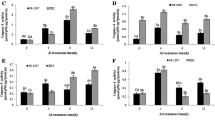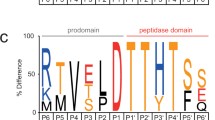Abstract
The tomato (Lycopersicon esculentum) fruit is the best available model to study the stress response of fleshy fruit. Programmed cell death (PCD) plays an important role in stress responses in mammals and plants. In this study, we provide evidence that PCD is triggered in the tomato fruit heat stress response by detection of the sequential diagnostic PCD events, including release of cytochrome c, activation of caspase-like proteases and the presence of TUNEL-positive nuclei. Investigating the time course of these events for 12 h after heat treatment indicated that cytochrome c release and caspase-like protease activation occurred rapidly and were consistent with the onset of DNA fragmentation. In addition, LEHDase and DEVDase enzymes were specifically activated in tomato fruit pericarp during the heat treatment and recovery time. There was no significant activation of YVADase or IETDase proteases. Preincubation of pericarp discs with the broad-spectrum, cell-permeable caspase inhibitor Z-VAD-FMK, suppressed heat-induced cell death measured by trypan blue, accompanied by a decrease in LEHDase and DEVDase activities.





Similar content being viewed by others
Abbreviations
- AMC:
-
7-Amino-4-trifluoromethyl coumarin
- CHO:
-
Aldehyde
- COX:
-
Cytochrome c oxidase
- DAPI:
-
4′-6-Diamidino-2-phenylindole
- DEVD:
-
N-acetyl-Asp-Glu-Val-Asp
- HS:
-
Heat stress
- IETD:
-
N-acetyl-Ile-Glu-Thr-Asp
- LEHD:
-
N-acetyl-Leu-Glu-His-Asp
- PCD:
-
Programmed cell death
- TUNEL:
-
Terminal deoxynucleotidyl transferase mediated dUTP nick end labeling
- YVAD:
-
N-acetyl-Tyr-Val-Ala-Asp
- Z-VAD-FMK:
-
Z-Val-Ala-Asp(OCH3)-Fluoromethylketone
References
Baker CJ, Mock NM (1994) An improved method for monitoring cell death in cell suspension and leaf disc assays using evans blue. Plant Cell Tiss Org Cult 39:7–12
Baliga BC, Read SH, Kumar S (2004) The biochemical mechanism of caspase-2 activation. Cell Death Differ 11:1234–1241
Balk J, Leaver CJ, McCabe PF (1999) Translocation of cytochrome c from the mitochondria to the cytosol occurs during heat induced programmed cell death in cucumber plants. FEBS Lett 463:151–154
Boatright KM, Renatus M, Stennicke HR, Scott FL, Sperandio S, Shin H, Pedersen IM, Ricci JE, Edris WA, Sutherlin DP, Green DR, Salvesen GS (2003) A unified model for apical caspase activation. Mol Cell 11:529–541
Bosch M, Franklin-Tong VE (2007) Temporal and spatial activation of caspase-like enzymes induced by self-incompatibility in Papaver pollen. Proc Natl Acad Sci USA 104:18327–18332
Bossy-Wetzel E, Newmeiyer DD, Green DR (1998) Mitochondrial cytochrome c release in apoptosis occurs upstream of DEVD-specific caspase activation and independently of mitochondrial transmembrane depolarization. EMBO J 17:37–49
Bozhkov PV, Suarez MF, Filonova LH, Daniel G, Zamyatnin AA Jr, Rodriguez-Nieto S, Zhivotovsky B, Smertenko A (2005) Cysteine protease mcII-Pa executes programmed cell death during plant embryogenesis. Proc Natl Acad Sci USA 102:14463–14468
Bradford MM (1976) A rapid and sensitive method for the quantitation of microgram quantities of protein utilizing the principle of protein-dye binding. Anal Biochem 72:248–254
Chen HM, Zhou J, Dai YR (2000) Cleavage of lamin-like proteins in vivo and in vitro apoptosis of tobacco protoplasts induced by heat shock. FEBS Lett 480:165–168
Coffeen WC, Wolpert TJ (2004) Purification and characterization of serine proteases that exhibit caspase-like activity and are associated with programmed cell death in Avena sativa. Plant Cell 16:857–873
Danon A, Rotari VI, Gordon A, Mailhac N, Gallois M (2004) Ultraviolet-C overexposure induces programmed cell death in Arabidopsis, which is mediated by caspase-like activity and which can be suppressed by caspase inhibitors, p35 and defender against apoptotic death. J Biol Chem 279:779–787
De Jong AJ, Hoeberichts FA, Yakimova ET, Maximova E, Woltering EJ (2000) Chemical-induced induced apoptotic cell death in tomato cells: involvement of caspase-like proteases. Planta 11:656–662
Filonova LH, Bozhkov PV, Brukhin VB, Daniel G, Zhivotovsky B, Arnold SV (2000) Two waves of programmed cell death occur during formation and development of somatic embryos in the gymnosperm, Norway spruce. J Cell Sci 113:4399–4411
Fray RG, Grierson D (1993) Identification and genetic analysis of normal and mutant phytoene synthase genes of tomato by sequencing, complementation and co-suppression. Plant Mol Biol 22:589–602
Fulda S, Meyer E, Friesen S, Susin SA, Kroemer G, Debatin KM (2001) Cell type specific involvement of death receptor and mitochondrial pathways in drug-induced apoptosis. Oncogene 20:1063–1075
Giovannoni JJ (2001) Molecular biology of fruit maturation and ripening. Annu Rev Plant Physiol Plant Mol Biol 52:725–749
Guerrero AD, Chen M, Wang J (2008) Delineation of the caspase-9 signaling cascade. Apoptosis 13:177–186
Hatsugai N, Kuroyanagi M, Yamada K, Meshi T, Tsuda S, Kondo M, Nishimura M, Hara-Nishimura I (2004) A plant vacuolar protease, VPE, mediates virus-induced hypersensitive cell death. Science 305:855–858
He R, Drury GE, Rotari VI, Gordon A, Willer M, Farzaneh T, Woltering EJ, Gallois P (2008) Metacaspase-8 modulates programmed cell death induced by ultraviolet light and H2O2 in Arabidopsis. J Biol Chem 283:774–783
Iwahashi Y, Horigane AK, Yoza K, Nagata T, Hosoda H (1999) The study of heat stress in tomato fruits by NMR microimaging. Magn Reson Imaging 17:767–772
Jiang XJ, Wang XD (2004) Cytochrome c-mediate apoptosis. Annu Rev Biochem 73:87–106
Johnson CR, Jarvis WD (2004) Caspase-9 regulation: an update. Apoptosis 9:423–427
Kawai-Yamada M, Ohmori Y, Uchimiya H (2004) Dissection of Arabidopsis Bax inhibitor-1 suppressing Bax-, hydrogen peroxide-, and salicylic acid-induced cell death. Plant Cell 16:21–32
Kim M, Lim JH, Ahn CS, Park K, Kim GT, Kim WT, Pai HS (2006) Mitochondria-associated hexokinases play a role in the control of programmed cell death in Nicotiana benthamiana. Plant Cell 18:2341–2355
Li P, Nijhawan D, Budihardjo I, Srinivasula SM, Ahmad M, Alnemri ES, Wang XD (1997) Cytochrome c and dATP-dependent formation of Apaf-1/Caspase-9 complex initiates an apoptotic protease cascade. Cell 91:479–489
Lurie A, Handros A, Fallik E, Shapira R (1996) Reversible inhibition of tomato fruit gene expression at high temperature. Plant Physiol 110:1207–1214
Madeo F, Herker E, Maldener C, Wissing S, Lachelt S, Herlan M, Fehr M, Lauber K, Sigrist SJ, Wesselborg S, Frohlich KU (2002) A caspase-related protease regulates apoptosis in yeast. Mol Cell 9:911–917
Oaull RE, Chen NJ (2000) Heat treatment and fruit ripening. Post Biol Tech 21:21–37
Overmyer K, Brosche M, Pellinen R, Kuittinen T, Tuominen H, Ahlfors R, Keinanen M, Saarma M, Scheel D, Kangasjarvi J (2005) Ozone-induced programmed cell death in the Arabidopsis radical-induced cell death1 mutant. Plant Physiol 137:1092–1104
Palma T, Marangoni AG, Stanley DW (1995) Environmental stresses affect tomato microsomal membrane function differently than natural ripening and senescence. Post Biol Tech 6:257–273
Pan JW, Zhu MY, Chen H (2001) Aluminum-induced cell death in root-tip cells of barley. Environ Exp Bot 46:71–79
Polenta G, Lucangeli C, Budde C, Vonzalez CB, Murray R (2006) Heat and anaerobic treatments affected physiological and biochemical parameters in tomato fruits. LWT Food Sci Technol 39:27–34
Renatus M, Stennicke HR, Scott FL, Liddington RC, Salvesen GS (2001) Dimer formation drives the activation of the cell death protease caspase 9. Proc Natl Acad Sci USA 98:14250–14255
Riedl SJ, Salvesen GS (2007) The apoptosome: signaling platform of cell death. Nat Rev Mol Cell Biol 8:405–414
Rogers HJ (2006) Programmed cell death in floral organs: How and why do flowers die? Ann Bot 97:309–315
Sabehat A, Weiss D, Lurie S (1996) The correlation between heat shock protein accumulation and persistence and chilling tolerance in tomato fruit. Plant Physiol 110:531–537
Saijo N (1973) A spectrophotometric quantitation of cytotoxic action of antiserum and complement by trypan blue. Immunology 24:683–690
Saltveit ME (1989) Effect of alcohols and their interaction with ethylene on the ripening of epidermal pericarp discs of tomato fruit. Plant Physiol 90:167–174
Samadi L, Behboodi BS (2006) Fusaric acid induces apoptosis in saffron root-tip cells: roles of caspase-like activity, cytochrome c, and H2O2. Planta 225:223–234
Sanmartin M, Jaroszewski L, Raikhel NV, Rojo E (2005) Caspases. Regulating death since the origin of life. Plant Physiol 137:841–847
Slee EA, Harte MT, Kluck RM, Wolf BB, Casiano CR, Newmeyer DD, Wang HG, Reed JC, Nicholson DW, Alnemri ES, Green DR, Martin SJ (1999) Ordering the cytochrome c-initiated caspase cascade: hierarchical activation of caspases-2, -3, -6, -7, -8, and -10 in a caspase-9-dependent manner. J Cell Biol 144:281–292
Thomas SG, Franklin-Tong VE (2004) Self-incompatibility triggers programmed cell death in Papaver pollen. Nature 429:305–309
Vacca RA, Valenti D, Bobba A, Merafina RS, Passarella S, Marra (2006) Cytochrome c is released in a reactive oxygen species-dependent manner and is degraded via caspase-like proteases in tobacco Bright-Yellow 2 Cells en route to heat shock-induced cell death. Plant Physiol 141:208–219
Whitlow TH, Bassuk NL, Ranney TG, Reichert DL (1992) An improved method for using electrolyte leakage to assess membrane competence in plant tissues. Plant Physiol 98:198–205
Woltering EJ, van der Bent A, Hoeberichts FA (2002) Do plant caspases exist? Plant Physiol 130:1764–1769
Xu Y, Hanson MR (2000) Programmed cell death during pollination-induced petal senescence in petunia. Plant Physiol 122:1323–1334
Yahia EM, Soto-Zamora G, Brecht JK, Gardea A (2007) Postharvest hot air treatment effects on the antioxidant system in stored mature-green tomatoes. Post Biol Tech 44:107–115
Yao N, Eisfelder BJ, Marvin J, Greenberg JT (2004) The mitochondrion—an organelle commonly involved in programmed cell death in Arabidopsis thaliana. Plant J 40:596–610
Zuppini A, Bugno V, Baldan B (2006) Monitoring programmed cell death triggered by mild heat shock in soybean-cultured cells. Funct Plant Biol 33:617–662
Acknowledgments
This work was supported by grants from the National Nature Science Foundation of China (nos. 30500352 and 30430490) and a grant from the 11th Five-year Plan of the China Science and Technology Support Programme (2006BAD22B01).
Author information
Authors and Affiliations
Corresponding author
Additional information
Gui-Qin Qu and Xiang Liu contributed equally to this work.
Rights and permissions
About this article
Cite this article
Qu, GQ., Liu, X., Zhang, YL. et al. Evidence for programmed cell death and activation of specific caspase-like enzymes in the tomato fruit heat stress response. Planta 229, 1269–1279 (2009). https://doi.org/10.1007/s00425-009-0908-4
Received:
Accepted:
Published:
Issue Date:
DOI: https://doi.org/10.1007/s00425-009-0908-4




